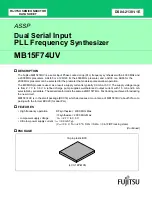
3
Arpeggiator
Overview
Basics
This is a MIDI arpeggiator device:
- It is driven by MIDI note events on its
MIDI input, which it
captures in its internal
chord buffer.
- It continually
scans this chord buffer
according to the current settings and
produces MIDI note events as output.
(Note: in this text, MIDI note event and
other input is referred to as coming from a
MIDI keyboard, although the arpeggiator
can of course be driven by
any live or
sequenced source of note events.)
The arpeggiator is monophonic. It puts out
one note at a time, no overlapping notes
and no chords.
MIDI Message Handling
The handling of received MIDI messages
depends on their type. In general:
- Received note-on messages are
captured in the chord buffer (up to sixteen
at any one time).
- Received note-off messages may or
may not cause the matching note-on
messages to be removed from the chord
buffer, depending upon the current
settings.
-
Received note messages are not echoed
to the output while the arpeggiator is
running. The note events which the
arpeggiator sends out are primarily those
which the arpeggiator itself
generates via
scanning of the captured chord.



































